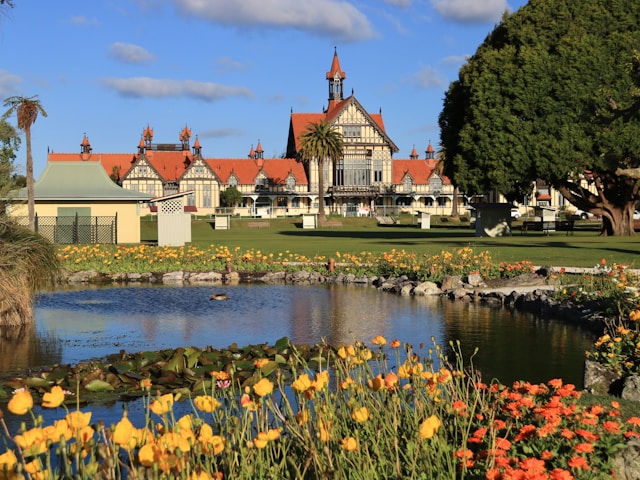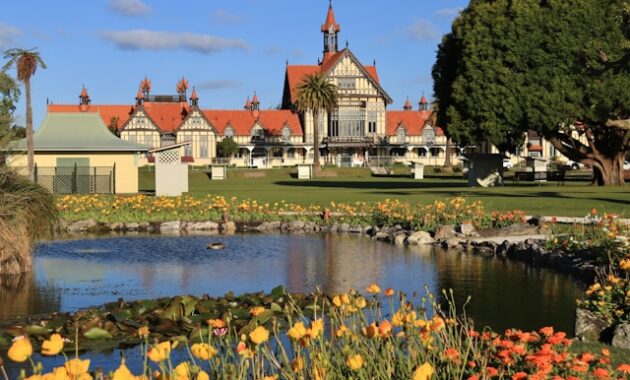
New Zealand, renowned for its breathtaking landscapes, is equally rich in historical landmarks that narrate the fascinating stories of its past. From indigenous Maori heritage to colonial influences, these iconic sites offer a glimpse into the nation’s cultural and historical tapestry. Join us as we delve into the tales behind some of New Zealand’s most celebrated landmarks.
Waitangi Treaty Grounds: The Birthplace of Modern New Zealand
The Waitangi Treaty Grounds, located in the Bay of Islands, is widely regarded as the cornerstone of New Zealand’s modern history. This is where, on February 6, 1840, the Treaty of Waitangi was signed between the British Crown and over 500 Maori chiefs. The treaty aimed to establish a framework for coexistence but also led to disputes over sovereignty and land rights.
Visitors can explore the beautifully restored Treaty House, a museum filled with historical artifacts, and the world’s largest ceremonial war canoe, the Ngatokimatawhaorua. The grounds also host cultural performances, providing a window into the Maori way of life.
Te Papa Tongarewa: Preserving Aotearoa’s Stories
Situated in Wellington, Te Papa Tongarewa is New Zealand’s national museum and a beacon of cultural preservation. Its name translates to “container of treasures,” and it lives up to this promise by housing a vast collection of Maori artifacts, geological wonders, and historical records.
One of the museum’s most compelling exhibits is Gallipoli: The Scale of Our War, created in partnership with Weta Workshop. The larger-than-life sculptures and immersive storytelling provide a poignant reminder of New Zealand’s role in World War I. The museum’s interactive displays make it a must-visit for history enthusiasts of all ages.
Rotorua’s Whakarewarewa Village: A Living Maori Heritage Site

Rotorua, famed for its geothermal wonders, is also home to the Whakarewarewa Thermal Village, where the Maori community has thrived for over 700 years. This living heritage site offers a rare opportunity to witness how the Maori people have harnessed geothermal energy for cooking, bathing, and heating.
Guided tours provide insights into Maori traditions, from haka performances to intricate wood carvings. The Pohutu Geyser, which erupts multiple times daily, serves as a spectacular natural backdrop to this cultural experience.
Otago Goldfields: Reliving the Gold Rush Era
The Otago region, nestled in the South Island, played a pivotal role during New Zealand’s 19th-century gold rush. Historic towns such as Arrowtown and Clyde still retain their gold-rush charm, with preserved buildings and informative museums.
Arrowtown’s Chinese Settlement, a restored area where Chinese miners lived, highlights the contributions and hardships of immigrant workers. Visitors can also try their hand at gold panning in the Arrow River, recreating the excitement of the 1860s gold fever.
Aoraki/Mount Cook National Park: Sacred Peaks of the Maori
Aoraki/Mount Cook is not just New Zealand’s tallest mountain; it is also a place of profound spiritual significance to the Maori. According to Maori legend, Aoraki and his brothers were turned into mountains when their canoe capsized, forming the Southern Alps.
The Aoraki/Mount Cook National Park offers a unique blend of natural beauty and cultural reverence. Hikers can explore trails like the Hooker Valley Track, which provides stunning views of the mountain, while guided tours delve into the Maori mythology surrounding these majestic peaks.
Larnach Castle: A Glimpse into Colonial Splendor
Perched on the Otago Peninsula, Larnach Castle is New Zealand’s only castle and a relic of its colonial past. Built in 1871 by William Larnach, a prominent businessman and politician, the castle boasts stunning architecture, manicured gardens, and tales of family drama.
The castle’s interior features opulent Victorian-era furnishings, while the surrounding gardens offer panoramic views of the peninsula. Special events, including high teas and historical reenactments, add to the allure of this landmark.
Cape Reinga: Where Spirits Depart
At the northernmost tip of New Zealand lies Cape Reinga, a place of deep spiritual importance to the Maori. According to Maori belief, this is where the spirits of the deceased embark on their journey to the afterlife, leaping off the headland and descending into the ocean.
The Cape Reinga Lighthouse stands as a sentinel at this windswept location, guiding modern travelers while preserving its sacred essence. The meeting of the Tasman Sea and the Pacific Ocean creates a dramatic display of crashing waves, symbolizing the confluence of life and death.
Dunedin Railway Station: A Masterpiece of Edwardian Architecture
Known as the “gingerbread house” of New Zealand, the Dunedin Railway Station is a stunning example of Edwardian Baroque architecture. Designed by George Troup and completed in 1906, the station was once the country’s busiest transport hub.
The intricate detailing of the station’s facade and its mosaic-tiled booking hall make it a visual treat. Today, the station hosts art galleries, markets, and the Taieri Gorge Railway, offering scenic journeys through Otago’s rugged landscapes.
Akaroa: A Slice of French Heritage
Nestled on the Banks Peninsula, Akaroa is a charming town with a unique French influence. Established by French settlers in the 1840s, the town retains its European flair with colonial cottages, quaint cafes, and street names in French.
Visitors can explore historical sites like the Akaroa Museum and learn about the town’s colonial past. Akaroa’s harbor also offers wildlife cruises, where you can spot Hector’s dolphins, the world’s smallest and rarest dolphin species.
Conclusion
New Zealand’s historical landmarks are more than just places to visit—they are stories etched into the land, offering insights into the nation’s diverse heritage. From the sacred grounds of Waitangi to the colonial elegance of Larnach Castle, these sites weave a narrative that connects the past with the present. Whether you are a history buff, a cultural enthusiast, or an adventurer, New Zealand’s historical landmarks promise an enriching experience.